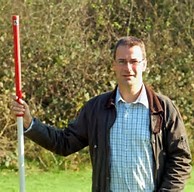
After last week’s rain, we experienced scorching-hot weather on site during week two of our excavation. Nevertheless, our team of students and volunteers persevered and we are beginning to piece together more clues of what life was like at the settlement at Ipplepen. Thanks to radiocarbon dates taken last year, we now know that there was activity at our site since at least the middle Iron Age, and this activity continues in the Romano-British period- and beyond- into the Early Medieval period (sometimes referred to as the ‘dark ages’). This makes our site the longest period of activity currently known in Devon!
On Friday, Professor Stephen Rippon gave a site tour to students and volunteers of our findings on the excavation so far.
The three trenches (trenches 13, 14, and 15) that we are currently excavating have all brought up Roman pottery. Some of this pottery has been made in Britain, but much of it has been imported from the Mediterranean area. These imported wares include fragments of amphorae- large storage jars containing goods such as olive oil and wine, and Samian ware- ‘fancy’ decorated table ware. This type of imported pottery suggests that the inhabitants at Ipplepen were very much connected to the Roman world.
In trench 13, we have discovered the remains of a curvilinear ditch- which is probably a ‘ring ditch’ associated with a roundhouse. A ditch was often dug around the outside of a roundhouse so that the rain would soak away into it, in order to prevent the floors of the house itself becoming damp and muddy. As roundhouses were made of organic materials (thatched roofs, wattle and daub walls) which do not survive, often the only indicator of a roundhouse is the deep ditch which was cut out around the house. Also in trench 13, there is at least one deep pit- not yet fully excavated -which might possibly be a well for water (watch this space!). In the same trench, we have discovered four post holes in a square shape, measuring about 1m square so there is a working hypothesis that this might indicate a store for grain, (termed a ‘granary’). Granaries were often raised above the ground (a bit like a very large roofed bird table- but four posts instead of one!) which would prevent rats and mice from getting in and eating the food supplies.
In trench 14, there are several linear ditches which contain pottery dating from the Roman period. One of the ditches contains a lot of charcoal, so we hope to be able to take some radiocarbon dates, which would date the fill of the ditch. In other ditches and pits, we have found lots of iron working slag. Finding so much iron slag demonstrates that there must have been some industrial processing activities carried out nearby.
In trench 15, we have discovered two linear ditches which might possibly represent two ditches either side of a trackway (similar to ditches often seen on Devon country lanes today). Unlike the nearby robust Roman road we excavated in 2014 and 2015, this does not have a metalled surface, and was unlikely to be a ‘major’ routeway, but possibly served the local community of people living at the settlement.
We still have another two weeks to excavate so our interpretations (and dating) of the various features we have might change over the next few weeks- but we are certain that we are finding more evidence of Roman trade and influence, that we have uncovered another roundhouse and, due to the presence of iron slag, have some form of iron working nearby.
We are probably looking at many phases of settlement spanning hundreds of years. However, from our finds so far this season, one might start to imagine everyday life at this multi-period settlement- people digging ditches to keep the rain out of their house; storing grain above the ground so that it isn’t eaten by rodents; making iron for tools such as spades to dig drainage ditches around houses, or perhaps making iron ploughs to furrow fields in which to grow grain or scythes to cut silage; using trackways to herd animals, or to walk along – maybe to visit family and friends whilst taking with them imported wine or olives in amphorae to celebrate a special occasion!
To find out more about the site visit our excavation open day on Sunday 25th June, 10.30am to 3.30pm.